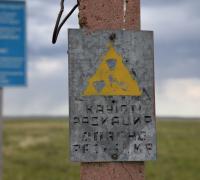Joe Biden administration must reduce risk of nuclear war
At a time when the Cold War nuclear arms control infrastructure has largely eroded, the Joe Biden administration faces a clear choice: accelerate the current nuclear arms race with Russia and, to a lesser extent, China. Or recognize that US national security is best served by reaffirming and renewing US commitment to the objective of nuclear disarmament and peaceful non-proliferation.
Whereas President Donald Trump unilaterally pulled out of arms control treaties, flirted with nuclear war with North-Korea and openly entertained the possibility of resuming nuclear testing, Biden clearly prefers the second option; however, his success will to a large extent depend on his administration’s ingenuity to navigate a complex set of nuclear challenges that are already piling up at the doorstep of the White House. Three of these are especially urgent:
1. The negotiations with Russia for a New Start Treaty
2. The reanimation of the Joint Comprehensive Plan of Action (JCPA), popularly known as the Iran nuclear deal
3. The ability to respond to critical, yet legitimate questions about the US nuclear posture and modernization program.
Another New Start?
The most immediate issue confronting the Biden administration is the extension of the 2010 New Start Treaty, which, unless the US and Russia agree to its extension, automatically expires in February 2021. Fortunately, a renewal of New Start appears straightforward and may already be a done deal before this piece comes in print. The Biden team is committed to a 5-year extension and Moscow is expected to accept. Even though relations between both states have deteriorated over the last decades, both Joe Biden and his Russian counterpart, Vladimir Putin, see considerable strategic advantage in the extension of a treaty that limits the number of deployed strategic nuclear warheads (up to 1,500 for each side) and imposes limits on the number of delivery systems.
And rightly so. Without the treaty, which includes on-site inspections by the counterpart, uncertainty about intentions would likely fuel mutual mistrust, which in turn could accelerate the nuclear arms race. Should that happen, China, too, may react by exchanging its current defensive strategy for a more assertive posture, for example by significantly expanding its estimated current arsenal of 200-400 strategic warheads.
An extension of New Start also has significant symbolic value, as it is the only remaining nuclear arms control treaty between the United States and Russia after President Donald Trump formally withdrew the United States from the Intermediate-Range Nuclear Forces Treaty in August 2019. In extending New Start, the Joe Biden administration would send a clear message that the previous administration’s view of arms control as an unwarranted hindrance to US power no longer holds sway in Washington.
The Iran-nuclear deal
Like New Start, the Iran nuclear deal carries a great deal of symbolic weight. It serves as an example that non-proliferation can be achieved by peaceful means and offers a blueprint for similar efforts elsewhere. However, after the Trump administration unilaterally withdrew from the 2015 JCPA in 2018, the deal has collapsed. With US sanctions again in place, Iran has reverted to the process of enriching 20% uranium. While 20% uranium cannot be weaponized, it nonetheless is a major step towards the production of weapons-grade material.
Both Joe Biden and Iran’s President, Hassan Rouhani, have professed that they would like to restore the JCPA. Yet, the path forward is likely to be fraught. Teheran may push for more guarantees and safeguards before rejoining a framework that is at the mercy of convulsions in American domestic politics. Such concessions, in turn, may be difficult to agree to for the US, which is also hoping to limit Iran’s ballistic missile program in a separate agreement.
The presidential election in Iran in June 2021 only adds to the uncertainty and, ideally, negotiations about restoring the JCPA should be finalized this Spring. Former US Secretary of State, Mike Pompeo, made a quick outcome less likely, however, when he during his final days in office falsely linked Iran to the Islamic terrorist network of Al-Qaeda. In Iran, such comments may add to existing suspicions that the US is not committed to a peaceful solution. At home, in the US, Pompeo’s claim props up arguments that a normalization of diplomatic ties with Iran is morally indefensible.
Despite these difficulties, the nuclear deal is worth saving – if only because the alternatives are worse. On the one hand, preventing an Iranian bomb by military means would undoubtedly further undermine stability in an already highly unstable Middle East. On the other, a nuclear-armed Iran is feared to set off a wave of nuclear proliferation in the region. Saudi-Arabia, in particular, is likely to develop a nuclear capability, which in turn may drive states like Egypt and Turkey to follow suit.
Nuclear Modernization and No First Use
Extending the New Start Treaty and reviving the Iran-deal are important first steps towards the twin goals of disarmament and non-proliferation, but skepticism about the US nuclear posture is likely to remain. On 22 January 2021, just two days after Biden’s inauguration, the Treaty on the Prohibition of Nuclear Weapons came into force. The treaty includes a comprehensive set of prohibitions on participating in any nuclear weapon activities. Although the treaty is not binding for nuclear weapons states, which have all refused to sign it, its entry into force conveys a deep-felt global frustration with the policies of nuclear weapons states.
In the case of the US, the nature and character of its nuclear modernization program, a 1.3 trillion dollars overhaul of the US nuclear triad (land-based missiles, submarine and air-launched weapons), has come under increased scrutiny and is faulted for fueling a modernization race among nuclear weapons states. Joe Biden must now decide which elements of nuclear modernization make strategic sense and which ones do not. For example, Trump’s decision to deploy so-called low-yield warheads (still roughly the size of the bomb dropped on Hiroshima) on submarines is widely considered a superfluous addition to the US deterrent.
The 98 billion dollars plan to replace 400 silo-based intercontinental ballistic missiles (ICBMs), the so-called Minuteman III, is particularly controversial. Because these ICBMs are not mobile, they are launched on warning of an incoming attack – or risk being destroyed altogether. A false warning, of which there have been several during the Cold War, may therefore inadvertently cause a nuclear war. Instead of replacing land-based ICBMs on hair-trigger alert, the US could also choose to scale down this leg of the triad, instead relying more strongly on its submarine and air-launched capabilities. During his presidential campaign, Biden declared that no new nuclear weapons are needed. Yet, given the significant military, political and economic interests invested in nuclear modernization, such a vision ultimately depends on his pragmatic ability to broker political and economic deals on the federal and state levels.
The most crucial area where vested interests in nuclear modernization clash with Biden’s ideological convictions concerns the policy of (no) first use. Joe Biden will face pressure from prominent members of the Democratic Party to officially commit himself to a ‘no first strike’ policy – a position that he has previously supported himself. To Democratic lawmakers, a policy of ‘no first use’ would largely solve the dangers involved in the US principle of ‘presidential sole authority’, which gives the president exclusive authority to launch nuclear weapons for any reason at any time.
The wisdom of concentrating such formidable powers in the president are routinely called into question, most recently in the case of President Donald Trump. But the problem runs deeper than Trump. It is not a matter of individual aptitude but of democratic accountability: should one person have the power to order a nuclear launch, which could cause the death of millions of people? A commitment to a policy of no first use would help solve the issue, as it would allow the president to order a nuclear lauch only in response to a nuclear attack.
Joe Biden, then, faces pressures from left and right in his attempt to steer a course through these complex and interconnected set of nuclear challenges. Although it is naïve to expect a dramatic U-turn in US nuclear policy, the time may well be ripe for Biden to thoroughly review the future institutional shape and character of the US nuclear triad.
DIIS Eksperter


